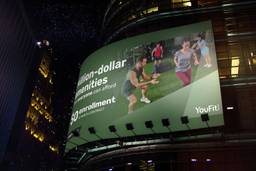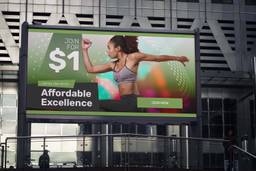For agencies and SMBs, connecting with audiences at the right moment is essential when it comes to driving leads and increasing campaign results. That’s why The Neuron, a global programmatic digital out-out-home (DOOH) DSP, set out to build a platform that enables SMBs and agencies to buy, manage, and plan DOOH advertising in real time. With access to premium OOH inventory, advertisers can easily integrate DOOH into wider omnichannel campaigns in a data-led, cost-effective way.
We recently spoke with Dima Nammari, COO of The Neuron DSP, to get her insights on everything from pDOOH advantages for SMBs and agencies to the future of programmatic in emerging markets.
What makes The Neuron unique?
The Neuron is a global marketplace for buying programmatic OOH advertising. We’re proud to say that the platform is currently connected to six leading SSPs (and counting), allowing our customers to automatically access over 1.1M unique, premium screens in +85 countries.
Our proprietary, easy-to-use, data-led platform offers flexible, real-time campaign planning and optimization capabilities that enable SMBs and agencies to deliver targeted, hyper-contextual campaigns that engage audiences at the right time, with the right message – and for the right budget. We believe that programmatic is the future, so we set out to build a platform to democratize out-of-home so that advertisers can book an ad anywhere in the world, no matter their level of experience.
While a typical marketer can spend weeks building the perfect local or global campaign strategy, you only need a few minutes to book and deliver an ad on The Neuron, exactly where and when it needs to be.
What type of businesses does The Neuron work with, and what are some key platform features that clients appreciate?
Our client portfolio is diverse and caters to users in over 20 sectors. Our SMB users appreciate the ability to geofence and handpick outdoor billboards of their choosing using our advanced search and geo-targeting functionality, which includes points of interest, all within a few easy clicks.
When it comes to agencies, The Neuron was designed with efficiency in mind. We built the platform to streamline the complexity of managing multiple client accounts and international DOOH campaigns. Agencies can plan, customize, and launch their clients’ ad campaigns in just a few steps and can then access advanced campaign performance reports that are updated in real-time, allowing them to optimize campaigns on the fly.
Other features that make The Neuron a unique DSP include our premium global inventory that we host through SSP integrations, the platform’s ability to ingest 1st and 3rd party data, advanced pacing and bidding algorithms, and the ability to dynamically trigger real-time campaigns based on factors like weather conditions, news, events, or any custom APIs.
Can you share an example of a client that successfully integrated programmatic DOOH into their omnichannel strategy?
YouFit gyms, a personalized and accessible gym, launched a month-to-month programmatic DOOH campaign aimed at enticing audiences to take control of their well-being across major cities in Florida. With The Neuron DSP, they were able to target hyper-local digital screens around gyms, deploying new digital creatives in a fraction of the time it takes with traditional OOH providers. This allowed them to experiment with different combinations of screens, locations, creatives, and traffic patterns to find the most efficient mix – and the results were outstanding! YouFit gyms saw a 21% increase in leads and a 25% increase in conversions. According to the client, DOOH helped them grow their omnichannel strategy and is quickly becoming one of their key business development tools.
In your opinion, what are the most successful use cases of pDOOH for SMBs?
OOH has always been considered a mass media channel for building brand awareness. It’s expensive, and not all SMBs could traditionally afford advertising on outdoor screens; however, that’s all changed with programmatic DOOH. You can now cherry-pick the screens that index the highest against your intended audiences, targeting them in locations they frequent at specific times and triggering creatives when they’re most relevant – all to yield the highest results and best ROI. And what’s best about it all is that there’s no minimum budget required!
Laderach, a Swiss chocolatier, ran a tactical campaign for 5 days in the run-up to Christmas. They used The Neuron’s POI tool to deliver ads during high-traffic hours on select screens around their stores in affluent neighbourhoods. As a result, they managed to significantly increase their exposure and sales compared to last year’s period.
What are some barriers preventing the wider adoption of pDOOH, and what can we do as an industry to make it easier for SMBs to buy DOOH?
It’s easy to see the appeal of DOOH, as it offers tangible results to small, independent, and local businesses. According to recent Nielsen research, we know that 49% of consumers notice digital street-level ads per month. Programmatic DOOH has democratized access to digital display advertising, and as such, DOOH advertising is no longer reserved for those with bottomless budgets and large marketing teams.
Having said that, there are still a few hurdles that the industry needs to overcome. We need to standardize certain aspects with media owners and SSPs, like the classification of screens and venue types, accurate ad duration requirements, and the ability to serve dynamic creatives. Moreover, while most publishers have removed all minimum buys, some still want a minimum booking amount. Certain publishers aren’t readily available on the open exchange and still require PMP deals to access their inventory. These types of conditions make it difficult for us to automate and streamline the process for SMB clients.
On the other hand, If we can standardize and automate the industry-recognized attribution, I expect many more traditional agencies to adopt pDOOH.
Where do you see pDOOH heading in 2023 with the current economic climate?
I think there will be a consistent uptake, with pDOOH making up an increasing percentage of DOOH spending. In 2022, it made up nearly 14.8% of DOOH spending compared to 3.2% in 2019 – that’s nearly a five-fold percentage increase in just a few years, and it’s a significant growth rate for relatively new technology.
Many big agencies are already using pDOOH or have at least been exposed to it, but we’re now seeing more and more digital agencies adopt pDOOH advertising as an extension of their client offerings. OOH is no longer a separate category; it’s now part of the digital sphere. In addition, OOH has traditionally been a conduit for building awareness and reaching mass audiences. Now, it’s also being used for tactical messaging and driving calls to action, whether it’s a QR code or directions to the closet shop.
Another avenue for expected growth is video ads in place-based environments. With CTV and DOOH as complimentary touch-points, brands can tell their story across multiple channels to strengthen their message.
What are some opportunities and challenges for the growth of pDOOH in emerging markets?
The adoption of programmatic advertising by media owners is gradual. While we’re seeing a high number of digital screens on roads and in place-based environments, publishers are still apprehensive about selling their ads programmatically for fear of breaking up their networks and losing out on revenue. Many large media owners are also investing in their own automation platforms, similar to SSPs, which can further fragment the market.
In my opinion, the pressure needs to come from the buy side. The biggest challenge for that to happen in emerging markets is the standardization of data and collection methodologies. There should be a unified trading currency and an accredited outdoor governing body.
What’s next for The Neuron?
We’d like to be the one-stop solution for buying any programmatically-enabled DOOH screen worldwide.
As the pDOOH industry’s power is unlocked and awareness increases, spending will grow too. Our main focus is scaling our SMB edition so that any client currently booking Facebook or Google Ads can equally and easily extend their advertising to include pDOOH.








